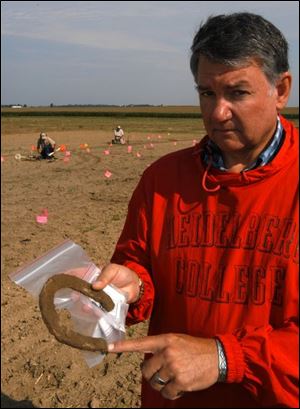
1830s family studied for Sauder Village
8/18/2004
As examination of a plot at the northwest corner of U.S. 20A and County Road 21 begins. Ernie Humberger of Oregon hunts objects with a metal detector. The small flags show places where items are believed to be.
ARCHBOLD, Ohio - History is being dug up at an Archbold farm, one 170-year-old rusty nail at a time.
An archaeological study sponsored by Sauder Village began yesterday at the site of the first settlement in Fulton County's German Township. Archaeologists are looking for remnants of a cabin built by the Lauber family in 1834.
"We tell the story of the earliest European settlers to this area, based on oral and written histories," said Debbie Sauder David, executive director of the museum. "Our hope is that this study will enhance that with actual physical evidence of the daily lives and activities of the people who lived here."
Today archaeologists will continue to survey the land for artifacts and decide where to dig when that process begins Sept. 11. Museum administrators hope they can learn enough about the cabin to build a replica for an early-settlement area they plan to add in the next two years.
"There hasn't been much archaeology in Ohio looking at these early individual cabin sites," said G. Michael Pratt, professor of anthropology at Heidelberg College's Center for Historic and Military Archaeology, who is heading the study. "This will tell us what life was like for the early settlers in this part of Ohio."
Yesterday workers walked metal detectors around the quarter-acre property located 3 1/2 miles northeast of Sauder Village on the northwest corner of U.S. 20A and County Road 21. It didn't take long to find a horseshoe, a fragment of window glass, chunks of ceramic, and an untold number of nails.
"We found an awful lot in the first hours of it," said Patty Pratt, who was working to categorize the items found. "In the first 10 minutes we had stuff."
The nails are being left in the ground because they help map where the cabin likely stood. Today the crew will check for irregularities underground by sending electromagnetic currents into the soil.

Professor G. Michael Pratt leads the excavation sponsored by Sauder Village.
"We'll be looking for structural evidence such as root cellars or any other kind of storage facility," Mr. Pratt said. "I think it's unlikely that we're going to find the actual walls of this cabin."
That's because the land has been farmed continuously since the Lauber cabin came down. Lowell Rupp currently owns and farms the land. He said he doesn't need the parcel since he harvested wheat from it in November. What's more, he's a descendant of the Lauber family.
"It'll be interesting to find out what they come up with," he said. "We're excited about it, all the family."
The Lauber family emigrated from the Alsace-Lorraine region (now in France) in the early 1830s, said Kris Jemmott, the museum's director of historic operations.
They traveled with a group of about five families, all peasant farmers. The Laubers had family in eastern Ohio but couldn't afford to live there because property cost too much.
The party eventually made its way to German Township.
"Not too many people lived up here because of the swamp," said Mrs. Jemmott. "Right away you know these people had to have a lot of courage."
It is not known how long the Laubers occupied their original home. Mr. Pratt said it's likely the family moved out of the cabin and left only behind what they didn't want. Still, the Laubers' garbage is Sauder Village's treasure.
"Even just those little shards of pottery" would be great for a display, Mrs. Jemmott said. "Anything we find is more than we had."
The Lauber family is already honored at the village with a cabin built in the 1970s. That is deteriorating and cannot be moved to the east side of the village, where the addition is planned. Museum administrators hope the dig will provide information that will make the new Lauber cabin more accurate.
Mr. Pratt said that's what archaeology is all about.
"You take what's left and use that to reassemble a picture of what was originally here," he said.
Contact Meredith Heagney at:
mheagney@theblade.com
or 419-724-6050.